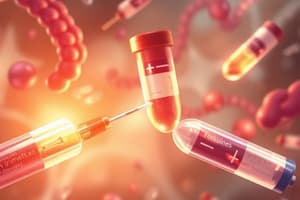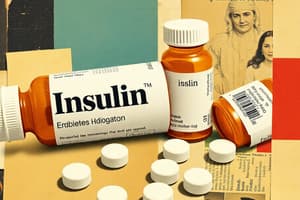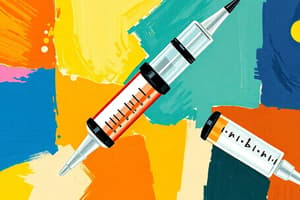Podcast
Questions and Answers
A patient with type 1 diabetes is prescribed rapid-acting insulin before meals. Which statement correctly explains why oral agents like metformin are insufficient for managing their condition?
A patient with type 1 diabetes is prescribed rapid-acting insulin before meals. Which statement correctly explains why oral agents like metformin are insufficient for managing their condition?
- Oral agents are contraindicated in type 1 diabetes due to the risk of severe lactic acidosis.
- Type 1 diabetes is characterized by insulin resistance, which is not effectively managed by oral hypoglycemic agents.
- Metformin primarily reduces glucose production by the liver and does not address the pancreas's inability to produce insulin in type 1 diabetes. (correct)
- Oral agents interfere with the absorption of exogenous insulin, making insulin therapy ineffective.
Administering intermediate-acting insulin (NPH) immediately before a meal is an optimal strategy for glycemic control due to its rapid onset of action.
Administering intermediate-acting insulin (NPH) immediately before a meal is an optimal strategy for glycemic control due to its rapid onset of action.
False (B)
What specific instruction should be given to a patient taking pramlintide (Symlin) regarding the timing of oral medication administration?
What specific instruction should be given to a patient taking pramlintide (Symlin) regarding the timing of oral medication administration?
Oral medications should be taken 1 hour prior to pramlintide injections.
The concurrent use of beta-blockers and insulin can mask the typical symptoms of ______, posing a risk to patients with diabetes.
The concurrent use of beta-blockers and insulin can mask the typical symptoms of ______, posing a risk to patients with diabetes.
Match the following insulin types with their peak action times:
Match the following insulin types with their peak action times:
Why is it crucial to withhold metformin in patients undergoing procedures involving contrast medium?
Why is it crucial to withhold metformin in patients undergoing procedures involving contrast medium?
Sulfonylureas, such as glyburide, are primarily used in type 1 diabetes to stimulate insulin production from the pancreas.
Sulfonylureas, such as glyburide, are primarily used in type 1 diabetes to stimulate insulin production from the pancreas.
Why might a patient with type 2 diabetes exhibit no noticeable manifestations of the disease despite having elevated blood glucose levels?
Why might a patient with type 2 diabetes exhibit no noticeable manifestations of the disease despite having elevated blood glucose levels?
A client with a history of prediabetes is attending a health education class. Which statement indicates an inadequate understanding of prediabetes management?
A client with a history of prediabetes is attending a health education class. Which statement indicates an inadequate understanding of prediabetes management?
Administering intravenous dextrose is the first-line treatment to address the acid-base imbalance in a client experiencing diabetic ketoacidosis (DKA).
Administering intravenous dextrose is the first-line treatment to address the acid-base imbalance in a client experiencing diabetic ketoacidosis (DKA).
A client with diabetes reports consistently elevated blood glucose levels around 150 mg/dL. According to the information, when should insulin be administered to this client?
A client with diabetes reports consistently elevated blood glucose levels around 150 mg/dL. According to the information, when should insulin be administered to this client?
In the context of cancer development, mutated __________ genes fail to inhibit cell division or promote apoptosis, thus removing a critical brake on cell division.
In the context of cancer development, mutated __________ genes fail to inhibit cell division or promote apoptosis, thus removing a critical brake on cell division.
Match the following symptoms with the potential underlying condition:
Match the following symptoms with the potential underlying condition:
A client with diabetes is prescribed a continuous glucose monitoring system (CGMS) integrated with an insulin pump. Which of the following statements reflects the most critical aspect of managing this technology?
A client with diabetes is prescribed a continuous glucose monitoring system (CGMS) integrated with an insulin pump. Which of the following statements reflects the most critical aspect of managing this technology?
Acquired genetic mutations, unlike inherited mutations, are present in all cells of the body from birth and are passed down from parent to child.
Acquired genetic mutations, unlike inherited mutations, are present in all cells of the body from birth and are passed down from parent to child.
A client receiving chemotherapy develops irritation at the IV site during infusion. What is the immediate priority nursing intervention?
A client receiving chemotherapy develops irritation at the IV site during infusion. What is the immediate priority nursing intervention?
A client with diabetes presents with dehydration and an altered level of consciousness. Blood gas analysis reveals a pH less than 7.30. The nurse anticipates which immediate intervention, prior to administering sodium bicarbonate?
A client with diabetes presents with dehydration and an altered level of consciousness. Blood gas analysis reveals a pH less than 7.30. The nurse anticipates which immediate intervention, prior to administering sodium bicarbonate?
A standardized method used to describe the extent of cancer in a patient's body is known as the __________ system.
A standardized method used to describe the extent of cancer in a patient's body is known as the __________ system.
Flashcards
Rapid-acting Insulin
Rapid-acting Insulin
Works rapidly, eat within 15 minutes. Examples: Lispro (Humalog). Onset: 10-30 min; Peak: 30 min-3 hr; Duration: up to 5 hr.
Short-acting Insulin
Short-acting Insulin
Only insulin type that can be given IV. Onset: 30 min-1 hr; Peak: 2-5 hr; Duration: up to 8 hr.
Intermediate-acting Insulin
Intermediate-acting Insulin
Daily maintenance, not for mealtime. Peak after 4 hours can cause HYPOglycemia. Onset: 1.5-4 hr; Peak: 4-12 hr; Duration: up to 18 hr.
Long-acting Insulin
Long-acting Insulin
Signup and view all the flashcards
Metformin
Metformin
Signup and view all the flashcards
Glyburide
Glyburide
Signup and view all the flashcards
Pramlintide (Symlin)
Pramlintide (Symlin)
Signup and view all the flashcards
Type 1 Diabetes
Type 1 Diabetes
Signup and view all the flashcards
Polyuria
Polyuria
Signup and view all the flashcards
Polydipsia
Polydipsia
Signup and view all the flashcards
Polyphagia
Polyphagia
Signup and view all the flashcards
Prediabetes
Prediabetes
Signup and view all the flashcards
Diabetic Foot Care
Diabetic Foot Care
Signup and view all the flashcards
Hypoglycemia Definition
Hypoglycemia Definition
Signup and view all the flashcards
15/15 Rule
15/15 Rule
Signup and view all the flashcards
DKA Treatment
DKA Treatment
Signup and view all the flashcards
Proto-oncogenes
Proto-oncogenes
Signup and view all the flashcards
Tumor-suppressor genes
Tumor-suppressor genes
Signup and view all the flashcards
Study Notes
Medications for Diabetes
- Rapid-acting insulin includes Lispro (Humalog).
- Onset: 10-30 minutes.
- Peak: 30 minutes - 3 hours.
- Duration: Up to 5 hours.
- It works fast, and patients need to eat within 15 minutes of receiving it.
- It suits individuals without much mealtime flexibility.
- Short-acting insulin includes Regular Insulin (Humulin R).
- It is the only type that can be administered intravenously.
- Onset: 30 minutes - 1 hour.
- Peak: 2-5 hours.
- Duration: Up to 8 hours.
- It can be used for mealtimes but offers less flexibility.
- Administer 30-45 minutes prior to a meal for best results.
- Intermediate-acting insulin: NPH.
- Onset: 1.5-4 hours.
- Peak: 4-12 hours.
- Duration: Up to 18 hours.
- Not for mealtime but for daily maintenance.
- The peak after 4 hours raises concern for hypoglycemia.
- Long-acting insulin includes Glargine (Lantus) and Detemir (Levemir).
- Onset: 0.8-4 hours.
- Peak: No peak.
- Duration: 16-24 hours.
- Not for mealtime, but to help with daily maintenance of blood glucose (BG).
- Not used alone; mealtime coverage is still needed.
Oral Agents for Diabetes
- Biguanides, like Metformin, are a first-line treatment for diabetes and pre-diabetes.
- Metformin reduces glucose production by the liver.
- Take with meals.
- Withhold if contrast medium is used.
- Not for people with kidney and liver diseases or heart failure (HF).
- Staying hydrated helps prevent lactic acidosis.
- Sulfonylureas, like Glyburide, increase insulin production from the pancreas.
- Take with meals, 30 minutes prior to eating.
- Can lead to weight gain (WG).
Other Agents for Diabetes
- Amylin analogs, like Pramlintide (Symlin), slow gastric emptying and reduce postprandial glucagon secretion.
- Administer subcutaneously in the thigh or abdomen before meals.
- Oral medications should be taken 1 hour prior to injections.
- Use concurrently with insulin but do not mix with insulin.
- Discard opened vials after 4 weeks.
- Beta-blockers can cause hypoglycemia to go undetected.
Type 1 Diabetes
- It involves a pancreas problem.
- Origins are genetic, autoimmune, or viral.
- It features an abrupt onset.
- Characterized by little to no insulin, leading to too much sugar.
- Insulin is the only treatment.
- Assessment findings: weight loss, vision loss/problems, numbness/tingling.
- Manifestations include polyuria, polydipsia, and polyphagia.
Type 2 Diabetes
- It involves a cell problem and/or a pancreas problem.
- The pancreas is overworked and quits.
- Either insulin cannot get glucose into the cell, or not enough insulin is produced.
- Assessment findings: weight, vision loss/problems, numbness/tingling, recurrent infections.
- There can be no manifestations.
- Signs of hyperglycemia: 3 Ps, weakness, fatigue, hot and dry.
- Polyuria: frequent urination.
- Polydipsia: excessive thirst.
- Polyphagia: excessive hunger.
- Patients may feel tired or complain of not being able to heal or being sick more often.
Prediabetes
- Glucose levels aren't high enough to be diagnosed as diabetes.
- There are no symptoms.
- Screenings and lifestyle changes are crucial.
- Impaired Glucose Tolerance (IGT): OGTT - 140 to 199 mg/dL.
- Impaired Fasting Glucose (IFG): 100 to 125 mg/dL.
- Teaching involves undergoing screening for glucose and A1C.
- Manage risk factors, monitor for symptoms of diabetes.
- Maintain a healthy weight, exercise, and make healthy food choices.
Foot Care for Diabetic Patients
- Treatment:
- Maintain euglycemia.
- Manage pain.
- Prevent injury.
- Skin assessments and foot care are key.
- Always wear closed-toe shoes.
Glucose Monitoring for Diabetic Patients
- Regular serum glucose testing: normal range is 70-100 mg/dL.
- Give insulin when BG is around 150 mg/dL.
- Regular Hemoglobin A1c (HgA1C) testing should be done every 3-6 months.
- Keep HgA1C less than 7%.
- Glucometer: point of care/at-home self-monitoring.
- Continuous glucose monitoring systems: internal sensor reads every 1-5 minutes; can work for an insulin pump.
- Insulin pump: provides continuous insulin over a 24-hour period and requires frequent monitoring.
Treatment for Hypoglycemia
- Hypoglycemia is defined as glucose levels less than 70mg/dL
- Follow the 15/15 rule from the ADA:
- Consume 15 grams of fast-acting carbohydrates, such as:
- 4 glucose tablets (usually 4 grams per tablet).
- 1/2 cup (4 ounces) of fruit juice.
- 1 tablespoon of sugar or honey.
- 1/2 cup of regular soda (not diet).
- Wait 15 minutes for the sugar to be absorbed.
- Check blood sugar again; if it is still low, repeat the process.
- Consume 15 grams of fast-acting carbohydrates, such as:
Diabetic Ketoacidosis (DKA)
- First line of treatment:
- Airway management with head of bed (HOB) elevated.
- Assess level of consciousness.
- Administer IV fluids with an 18-gauge needle, using 1/2 normal saline (NS) at 150/75 mL/hour
- Administer insulin intravenously.
- Monitor electrolytes, especially potassium (K), and obtain an EKG if administering K.
- If IV BG levels go less than 250, give IV dextrose to keep the BG within normal limits (WNL).
- Administer sodium bicarbonate if acid-base imbalance goes unresolved.
- Pathophysiology: patients stop taking their medications or have more sugar as a result of illness/infection.
- High glucose results in a high osmotic effect, leading to excessive water in the bloodstream and the 3 Ps because cells are dehydrated, which increases blood glucose.
- Signs and symptoms of dehydration: poor skin turgor, sunken eyelids, increased heart rate (HR), decreased blood pressure (BP).
- pH less than 7.30 indicates acidosis.
Cancer Overview
- Lung cancer is the most deadly for both men and women.
- Prostate cancer is second for men and breast cancer is second for women.
- Most diagnoses occur over the age of 55.
- Cancer develops over time, not all at once.
- Proto-oncogenes are involved in normal cellular processes that encourage cell division.
- When mutated, growth-promoting pathways become overactive.
- Tumor-suppressor genes normally inhibit cell division and promote apoptosis.
- When mutated, critical tumor-suppressor proteins become inactive, removing the brake on cell division.
- Genetic mutations can be inherited from a parent or acquired from damage to genes over a lifetime.
- It usually takes decades to accumulate enough mutations to reach a malignant state.
- Exposure to carcinogens increases the likelihood that certain harmful changes will occur.
Benign vs. Malignant Tumors
- Benign tumors are non-cancerous.
- Small and slow-growing.
- Non-invasive and well-differentiated.
- Stay in one space and cannot metastasize.
- Malignant tumors are cancerous.
- Large and fast-growing.
- Invasive and poorly differentiated.
- Infiltrate, invade, and destroy surrounding tissue, then metastasize to other parts of the body.
TNM System for Cancer
- The TNM system is a standardized way to describe the extent of cancer in the patient's body.
Purpose of a Biopsy
- A biopsy is the only definitive way to diagnose cancer.
Management During Chemotherapy
- Chemotherapy is administered intravenously; watch for irritants vs. vesicants.
- Irritants cause damage to direct skin contact.
- Vesicants cause tissue damage.
- Provide oral care, ensure the patient eats, provide emesis bags, and administer medications for pain management.
Diagnostic Tests
- White Blood Cell (WBC) count normal range: 4,000-11,000.
- Platelet count normal range: 150,000-450,000.
- Hemoglobin normal range: 12.1-17.2.
- Hematocrit normal range: 37-54%.
- Serum Creatinine normal range: 0.6-1.3.
Studying That Suits You
Use AI to generate personalized quizzes and flashcards to suit your learning preferences.




